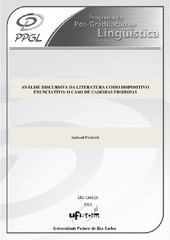| dc.contributor.author | Ponsoni, Samuel | |
| dc.date.accessioned | 2016-06-02T20:25:07Z | |
| dc.date.available | 2011-03-16 | |
| dc.date.available | 2016-06-02T20:25:07Z | |
| dc.date.issued | 2011-02-25 | |
| dc.identifier.citation | PONSONI, Samuel. Análise discursiva da literatura como dispositivo enunciativo : o caso de Cadeiras Proibidas. 2011. 146 f. Dissertação (Mestrado em Ciências Humanas) - Universidade Federal de São Carlos, São Carlos, 2011. | por |
| dc.identifier.uri | https://repositorio.ufscar.br/handle/ufscar/5702 | |
| dc.description.abstract | In Brazil, between 1964 and 1985, it was settled in the state s power a dictatorial regime led by the military that has restricted many civil and human rights of individuals or institutions that maintained political and ideological position against this repressive government. Although constrict by institutional censorship, artistic expressions of several kinds have not ceased entirely. There was resistance. Thus, given the importance of these art manifestation during the period as an attempt of escaping from the imposition of discursive silence, between them, literary manifestations, there are some studies which the goal is to reflect on the historical conditions that the works, by chance, carry with them: a background that covers the works; or studies in which structural, regulatory or styles made: an esthetic form that compose them. These researches are given in various theoretical lines, connected to literary theories, or linked to social theories. From another theory viewpoint, our objective with this thesis is to try to analyze what were the conditions of possibility of discursive enunciation, of a collection of short stories, published in Brazil during the historic period referred, analyzing it as an enunciative device of communication basically in two possibilities: a paratopic creation and scenography. For this, we took Cadeiras Proibidas by Ignacio de Loyola Brandão, for analysis, and from the assumptions listed, take it to a set of hypotheses, from authorial position in a literary field to the linguistic-discursive forms in scenography, in which the tales are engendered, making the text of the work its own regulation context. Therefore, mobilizing discursive analytical categories, especially those done by Dominique Maingueneau, but with nuances of other theorists of discourse analysis of French orientation, and try to answer these hypotheses and work analysis. | eng |
| dc.description.sponsorship | Universidade Federal de Minas Gerais | |
| dc.format | application/pdf | por |
| dc.language | por | por |
| dc.publisher | Universidade Federal de São Carlos | por |
| dc.rights | Acesso Aberto | por |
| dc.subject | Análise do discurso | por |
| dc.subject | Discurso literário | por |
| dc.subject | Paratopia | por |
| dc.subject | Cena enunciativa | por |
| dc.subject | Cenografia | por |
| dc.subject | Literary Discourse | eng |
| dc.subject | Paratopic | eng |
| dc.subject | Enunciative scene | eng |
| dc.subject | Scenography | eng |
| dc.title | Análise discursiva da literatura como dispositivo enunciativo : o caso de Cadeiras Proibidas | por |
| dc.type | Dissertação | por |
| dc.contributor.advisor1 | Baronas, Roberto Leiser | |
| dc.contributor.advisor1Lattes | http://lattes.cnpq.br/4613001301744682 | por |
| dc.description.resumo | No Brasil, entre 1964 e 1985, liderado por militares, instalou-se no poder do Estado um regime ditatorial que cerceou muitos direitos civis e humanos de indivíduos ou instituições que mantiveram posicionamento político-ideológico contra esse governo repressivo. Embora restritas por censuras institucionais, as manifestações artísticas de diversas ordens não cessaram totalmente. Houve resistência. Assim, dada a importância dessas manifestações artísticas durante o período como uma das tentativas de escapar à imposição do silêncio discursivo e, entre elas, as manifestações literárias, existem alguns estudos cujo objetivo é refletir sobre as condições históricas que as obras, porventura, carregam consigo: um pano de fundo que recobre o conteúdo dessas obras; ou, então, estudos cujo objetivo é refletir as propriedades estruturais, normativas ou de estilos empreendidos: uma forma estética que as compõe. Essas pesquisas se dão em diversas linhas teóricas, sejam ligadas a teorias literárias, sejam ligadas a teorias sociais. De outro mirante teórico, nosso objetivo com esta dissertação é tentar analisar quais foram as condições de possibilidade enunciativo-discursivas de uma coletânea de contos, publicada no Brasil durante o período histórico referido, analisando-a como um dispositivo enunciativo de comunicação em duas possibilidades basicamente: a criação paratópica e a cenografia. Para tanto, tomamos Cadeiras proibidas, do escritor brasileiro Ignácio de Loyola Brandão, como material de análise para, a partir das premissas elencadas, levá-lo a um conjunto de hipóteses que vão desde o posicionamento autoral em um campo literário até as formas linguístico-discursivas da cenografia, com a qual os contos estão engendrados, fazendo dos textos da obra a própria gestão do contexto. Dessa forma, mobilizando categorias analíticas discursivas, sobretudo as forjadas por Dominique Maingueneau, porém com matizes de outros teóricos da análise do discurso de orientação francesa, tentaremos responder a essas hipóteses e análises do trabalho. | por |
| dc.publisher.country | BR | por |
| dc.publisher.initials | UFSCar | por |
| dc.publisher.program | Programa de Pós-Graduação em Linguística - PPGL | por |
| dc.subject.cnpq | LINGUISTICA, LETRAS E ARTES::LINGUISTICA | por |
| dc.contributor.authorlattes | http://lattes.cnpq.br/6739815431846441 | por |
